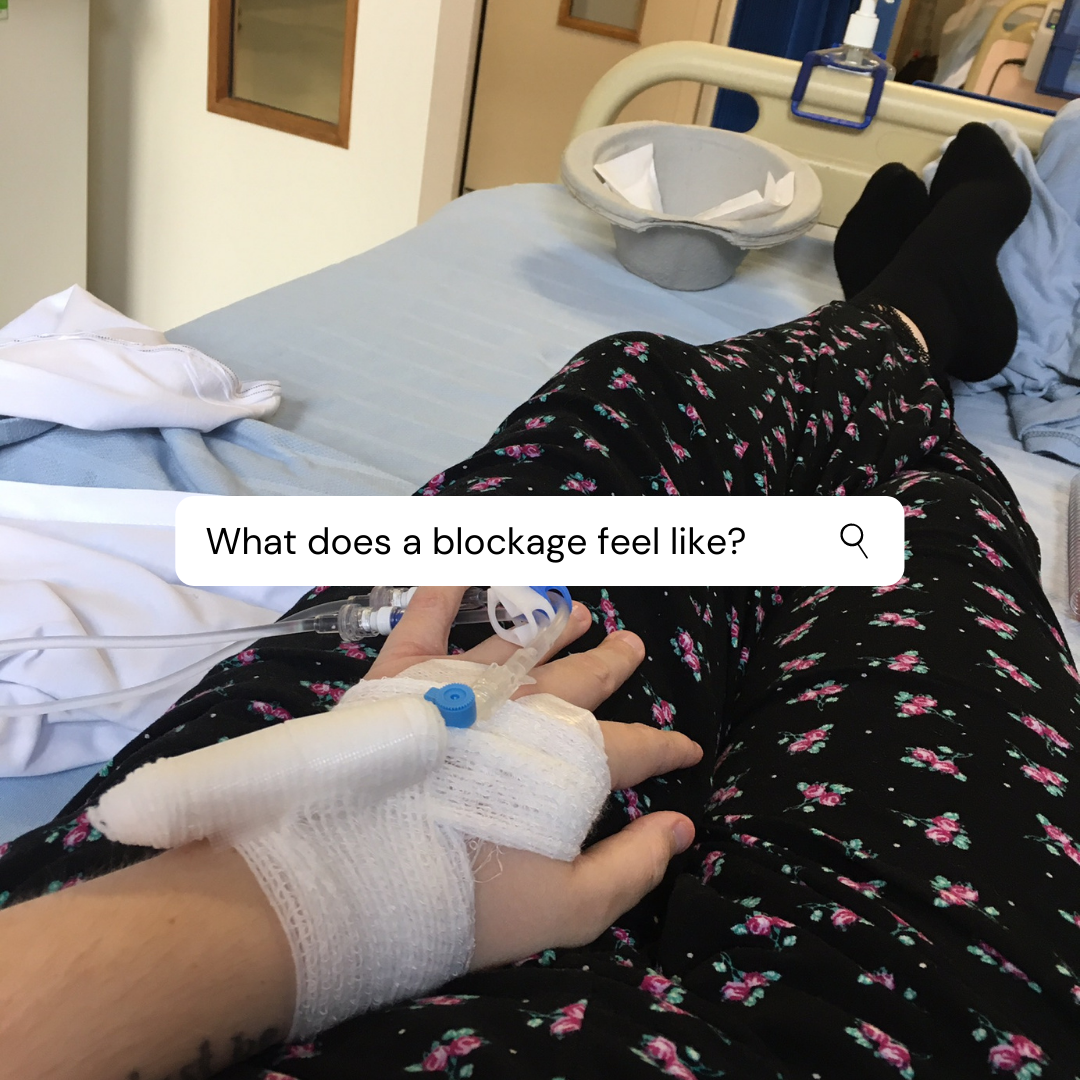
“What does a blockage feel like?”
So blockages. They are one of the big things stoma nurses and surgeons talk about before and immediately post-op to patients. Because you need a) a warning and b) they can be really tricky if your body doesn’t adapt to your new plumbing.
There are two types of blockage:
Partial – when a small amount of liquid can make it round the obstruction.
Full – when nothing can pass around the obstruction.
Three types of obstruction:
Mechanical – which are caused by something obstructing the bowel such as food or a foreign body.
Functional – no physical obstruction but narrowing, strictures or tumours.
Pseudo – symptoms of an obstruction but is caused by nerve damage, some narcotics or digestive diseases such as Gastroparesis.
For a person with a colostomy, a blockage could happen over several days and you may start with feeling constipated, so it might not be as obvious at first. For a person with an ileostomy, a blockage can happen fairly quickly and usually without any constipation.
Symptoms:
- Stoma output may slow down or may even stop working altogether
- An empty pouch
- Stomach-ache. You may start to feel waves of cramping and abdominal pain.
- Liquid or mucus type of offensive-smelling bowel motion from your stoma.
- Swollen abdomen.
- Nausea.
- The stoma itself might start to show signs of swelling or colour change.
- Dry mouth.
- Decrease in urine output.
- In severe cases – vomiting
How do they feel?
Like incredibly strong and painful stomach ache. You feel like you could explode but also very heavy, low and scared at the same time.
My experience
I’ve had several in my time with my stoma. My first was a full blockage which happened just shy of being three months post-op. I started with a dull ache in my abdomen which then turned into no output despite some joke remedies (see above) and resulted in two A&E trips, one of which was a three days stay on the surgical ward. That one I take responsibility for, not chewing well enough.
My others have been more partial but some have resulted in hospital admissions. At times, the partial obstruction has resolved itself while waiting for imaging to be done so doesn’t really get to be seen.
The final one in a run of about 6 weeks showed an obstruction after having some oral contrast. ( written about here) these were functional because I had a structure in my bowel. Medication has kept that ticking over.
Very occasionally a partial blockage comes along and I can remedy it at home without medical intervention. I’ve gotten wiser as my time has gone on but it only takes not chewing enough or my disease to create a new structure for it to happen again.
Others experiences
(Embed Twitter question here) and post responds with quote marks.
“A) I’ve only ever experienced “minor” blockages in the sense that I haven’t had to go into hospital for them* It normally manifests as pain across my abdomen, really severe B) It goes away eventually and is usu. only eased by a hot water bottle I use electrolytes after to recover.
one time I did call 111 and was told to go into A&E, that was early on. I don’t really remember how that occasion played out in the end but luckily things have always calmed down. It’s always miserable though.”
@WinnySharpe
“Bloated, pain behind stoma, gassy, bag filling with air but no output, nausea and sometimes vomiting too. But mainly distension and pain. Remedies – massage stomach, fizzy drinks, lying on my left side, heating pad or warm bath. But mainly you just have to wait for it to pass!
Also my actual stoma will change size and shape – it will go very swollen and large. I will sometimes get partial blockages – I’d say twice a month. Same symptoms but not as severe. Again just have to wait for it to pass!
And when it does pass, my bag will suddenly fill up rapidly with water/liquid output! Then continue to do so for a few hours until it’s fully passed and over with. So I’ll be having to empty constantly for a while too.”
@hlglass
Home remedies and when you seek medical attention
- Increase the amount of fluids you are drinking. Choose fresh fruit juices in addition to water and hot tea. Sometimes carbonated drinks may help.
- Gently massage around your stoma to try to encourage the blockage to work its way out.
- Have hot bath or try using a heat pad, as this may help your abdominal muscles relax so you can pass a bowel movement.
- If your stoma appears more swollen than usual, it may worth checking if the hole of your pouch needs to be cut slightly larger.
- Try lying down and lifting your knees to your chest, rolling gently from side to side.
- For people with a colostomy, your GP or Stoma Care Nurse may prescribe some laxatives, use these as prescribed and don’t forget to drink plenty of water with these as it will help them work better.
- Keep mobile as this will help your digestion and therefore help with the blockage.
If:
- The abdominal cramps become more severe.
- There is no output from the stoma for 8-12 hours
- You are showing signs of dehydration.
- Or you are vomiting
Call NHS 111 for advice or ask a friend or family member to drive you to the A&E department at your local hospital. Do NOT wait to seek medical attention

Until next time,

Do you have any questions or queries? Or just want to share your own experiences? You can leave me a reply here or leave comments via my social media accounts – on Twitter, find my blog page on Facebook and over on Instagram
If you enjoyed this post check out Ostomy Blockages: How to Cope and Experimenting and Exploring Food with an Ostomy




1 Comments
"Does your scar or stoma ever hurt?" •
06/10/2021 at 09:32
[…] you enjoyed this post check out “What does a blockage feel like?” and “What is life like after stoma […]